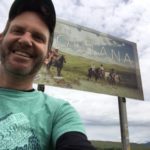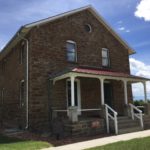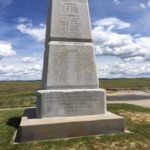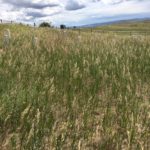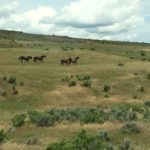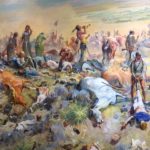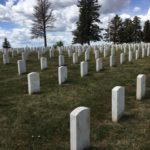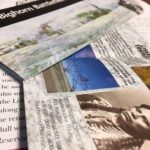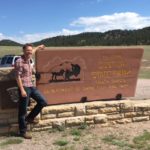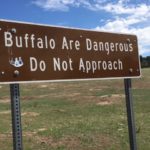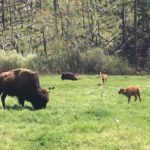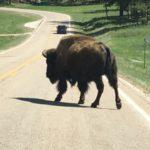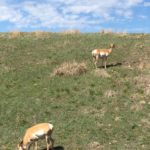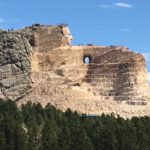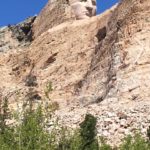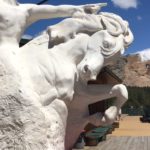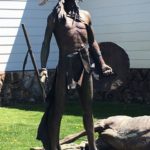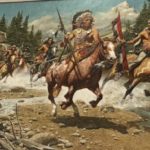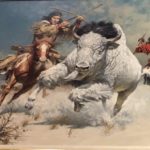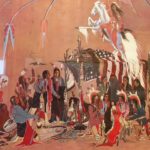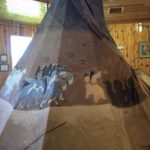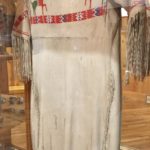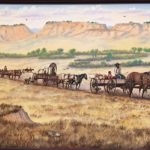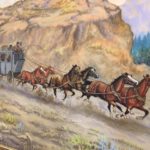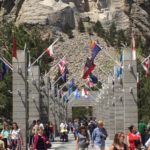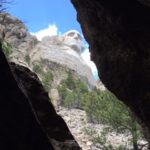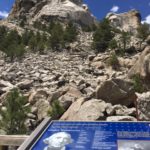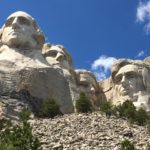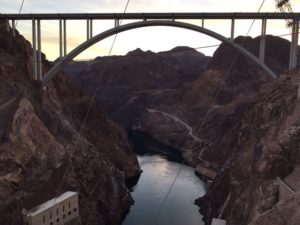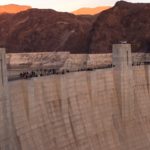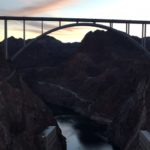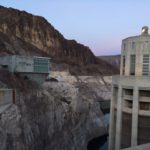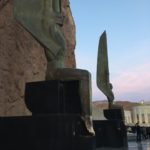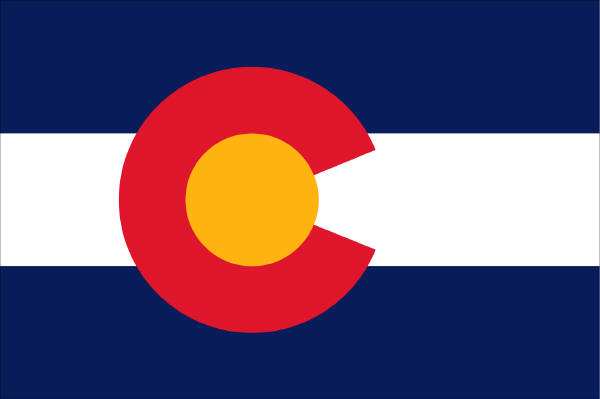Late arrival in Buffalo, cabin rental 20 minutes west of Dayton. Buffalo NY, Dayton Ohio? Heck no. I’m talking Wyoming. In town for Saturday’s ultra, Bighorn. One mile shake-out run along State Hwy 14, road trippin’ after breakfast.
Montana. 2 hours north on I-90.
Forty Mile Colony. Lodge Grass. Crow Agency. Today’s destination: Little Bighorn Battlefield on the Crow Reservation.
The Battle of the Little Bighorn (commonly referred to as Custer’s Last Stand) was an armed engagement between combined forces of the Lakota, Northern Cheyenne, and Arapaho tribes and the 7th Cavalry Regiment of the United States Army. The battle, which occurred June 25–26, 1876, along the Little Bighorn River in eastern Montana Territory, was the most significant action of the Great Sioux War of 1876.
The fight was an overwhelming victory for the Lakota, Northern Cheyenne, and Arapaho, who were led by several major war leaders including Crazy Horse and Chief Gall and had been inspired by the visions of Sitting Bull (Tȟatȟáŋka Íyotake). The U.S. 7th Cavalry, including the Custer Battalion, a force of 700 men led by Lieutenant Colonel George Armstrong Custer, suffered a major defeat. Five of the 7th Cavalry’s twelve companies were annihilated; Custer was killed, as were two of his brothers, a nephew, and a brother-in-law. The total U.S. casualty count included 268 dead and 55 severely wounded (six died later from their injuries), including four Crow Indian scouts and two Pawnee Indian scouts.
Purchased a guided tour at the Visitors Center, operated by Apsaalooke Tours (affiliated with the Crow Nation Office of Tourism). Bus tour was led by an enthusiastic Apsaalooke [Crow]. Details of the battle & war strategy were painstakingly reviewed. Additionally our guide shared his language, teaching [us] multiple native words: hello, goodbye, bird, coyote, mustang, mountain.
While I struggled with his accent & the story, the landscape around me was breathtaking. LOVED being here. Life is about seizing opportunity. I could have laid low the day before Bighorn…but a short 2 hours away, engaged/partook/learned ‘bout Custer’s Last Stand, a significant piece of U.S. history – a story retold by descendants of the native people who won that battle.
Inspired, I needed to know – so, how did it all end?
After Custer’s defeat, Sitting Bull, along with his people, fled north to Canada. In 1881, he returned to the United States to surrender. Sitting Bull was killed by Indian police on the Standing Rock Reservation in South Dakota on December 15, 1890.
Sad end to the Lakota spiritual leader – resisted westward expansion, in an effort to preserve the Lakota way of life.
- Custer Memorial
- Last Stand Hill
- wild mustang
- “Here Fell Custer”
- National Cemetery
- resisted westward expansion, to preserve the Lakota way of life
Little Bighorn Battlefield
4 weekends marathoning – this Saturday: kick around, do laundry? Heck no – road trippin’ SD: “Great Places, Great Faces”.
Ended Friday work week with my final father-daughter dance lesson. Too far/too late to reach South Dakota – but how ‘bout Lusk? [Wyoming of course 🙂 ] Small but clean digs, free buffet breakfast. Short hour-half drive to Custer State Park, car-dodging buffalo by 9am. FAAANNNTASTIC! Native to the U.S.A, our American bison – BIG, STRONG, MASSIVE. Personal fave of the animal kingdom.
20 minutes west thru Custer, 20 minutes north to Crazy Horse Memorial. Had heard mixed reviews ‘bout the Monument. Lakota Chief Henry Standing Bear commissioned the project in 1939 – Crazy Horse’s massive 87ft face wasn’t completed ’til 1998. Current work is focused on Crazy Horse’s hand, finger & his horse’s mane. Timeline? Long after my life span.
Paid an extra $10 to school bus-ride near the base of the Mountain. Felt a bit nickel-n-dimed but WOW – gotta say, being so close to something so massive, was well worth the $$. Wrong time to be short-sighted with cash. Once completed Crazy Horse will rival nearby Mt. Rushmore. Sculpted to ‘honor the culture & heritage of all North American Indians’. Just WOW.
Didn’t leave the Memorial Museum for almost 2 hours. LOVE LOVE LOVED! Native American artifacts, photographs, sculptures, paintings. Completely unexpected. WELL WORTH GOING!
Wait, wait – the day’s not over. Next up: Mount Rushmore. Washington, Jefferson, Roosevelt & Lincoln – literally carved IN the Black Hills of South Dakota. Short-hiked up-n-down the Presidential Walk. Fave spot? Rushmore’s ‘Walk of Flags’ entrance. Every state, every U.S. territory represented. Left beaming USA pride. Bought an ice cream recipe’d by Pres. Thomas Jefferson himself ❤
Sleeps in historic Deadwood. Dinner above the saloon where Wild Bill Hickok was killed, tomorrow visiting his marker.
- TATANKA!
- BIG, STRONG, MASSIVE
- Pronghorn antelope
- commissioned in 1939, Crazy Horse’s face wasn’t completed ’til 1998
- ‘completed’ (left), ‘in-progress’ (right)
- Native American artifacts, photographs, sculptures & paintings
- ‘Walk of Flags’ entry
- U-S-A pride
- short-hiked the Presidential Walk
- Washington, Jefferson, Roosevelt & Lincoln
Sand dunes, salt flats, mountain hike & my 77th marathon finish. Last desert day…all good things come to an end. Drove back by way of Dante’s View — one last hike in the Park, one last overlook of Death Valley. WOW, just WOW.
More than an afternoon in Vegas [’til my return flight]. Casino walk, afternoon show? Naw…been there, done there.
Hoover Dam.
Did a fly-over 2 years ago during my Grand Canyon Heli Tour, but never down, down, down to the Dam’s base nor studied its history.
At the time of its creation, Hoover Dam was the largest of its kind. Harnessing the power & volume of the mighty Colorado River, water is distributed amongst the West thru a system of pipes and irrigation canals. Hoover Dam’s reservoir, Lake Mead, is America’s largest man-made reservoir.
Dam construction created thousands of jobs during the country’s Great Depression & completed 2 years ahead of time. The Dam’s spillways were last tested in the 1980’s; since then water levels have diminished significantly, triggering renegotiation of the Colorado River Compact within the next 2 years. While Colorado snowpack has provided steady & consistent volume, population explosion in Las Vegas, Los Angeles, San Diego, Phoenix & Tucson have eroded Lake Mead’s levels.
Living in Colorado, many of us grow frustrated and anger at California’s seemingly wasteful use of water resources: creation of lush manicured lawns & agricultural water waste. Arid landscaping — popular in Colorado, New Mexico, Nevada & Arizona — has not been widely adopted in America’s most populous state.
…but I digress. Breathe in, count to 10, exhale 🙂
$20 was the ticket price for the tour. Historical film, followed by a series of elevator rides to the Dam’s bypass pipes & massive hydropower generators. The science as to how this all works — super interesting!
Elevator UP. Walked the Dam perimeter, snapped sunset shots, self-toured its Monument. Thank goodness for standby — ’cause this flyer missed his departure home. Many thanks Southwest Airlines. Life lesson learned.
- infamous California chain — check, done
- greatest dam of its day
- [Colorado] river was diverted through four 50-foot-diameter tunnels, two drilled through the canyon walls on each side of the river
- 4 billion kilowatt-hours a year — enough to serve 1.3 million people
- 3.25 million cubic yards of concrete
- tonite’s WOW shot!
- Lake Mead (Nevada left, Arizona right)
- Hoover Dam Monument
Hoover Dam (in 47 seconds)
